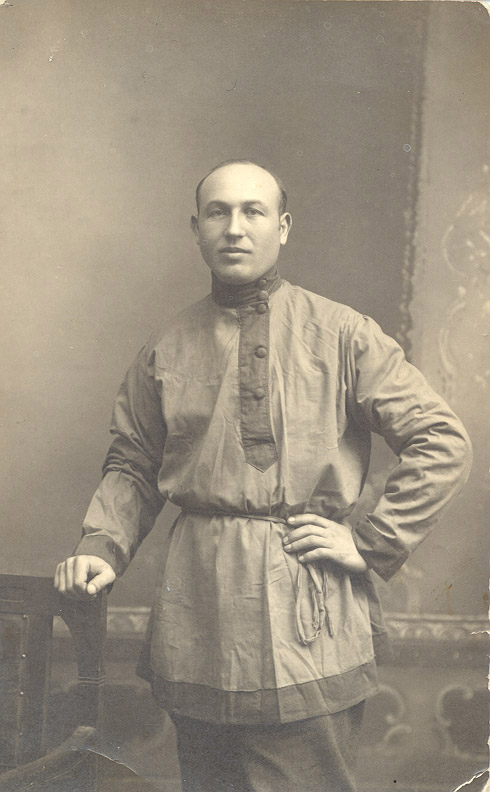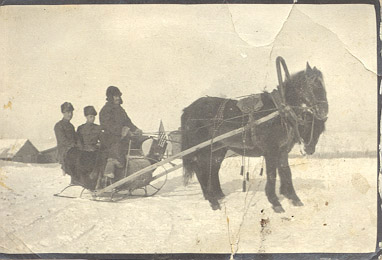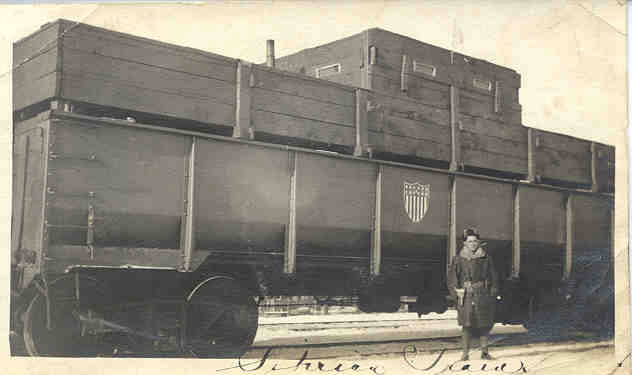
The following article appeared in a modified form in the publication "The Jewish Veteran", Spring 2000.

Benjamin Swartzberg in Khabarovsk, Siberia, Russia, 1919
Sent Back to Russia:
My Grandfather in the AEF Siberia
My favorite photograph of my grandfather shows him dressed in the costume of a native Russian. Anyone seeing this photo would assume that it was taken in my grandfather’s shtetl in Kovno Guberniya before he immigrated to America in 1905. The photograph indeed was taken in Russia, although some 15 years after my grandfather first came over to America. So what was he doing back in Russia? My grandfather, Benny Swartzberg, was serving his adopted country of America as a United States soldier serving in the American Expeditionary Forces in Siberia.
Benny Swartzberg passed away in 1985, a member of the Veteran of Foreign Wars. I was 19 when he died, and I regretted not speaking to him more about his life. For the past few years I have been researching his life so that I may learn more about his unique immigrant experience. Helping me in my research is a family album of photographs and my grandfather’s remarkable postcard collection.
Benny left his shtetl of Panimunok (now Panemunelis, Lithuania) at the age of 15. He settled in Whitman, Massachusetts, and worked in the shoe factories in the nearby city of Brockton. My grandfather had two hobbies as a young man -- taking photographs and collecting postcards. Many of the postcards collected by Benny were of Jewish themes and personalities. My grandfather was a great lover of Yiddish and an ardent Zionist and he collected postcards of famous Yiddish writers and Zionists. I have learned a great deal about my grandfather based on the postcards he collected.
When I began my research into my grandfather’s life, I became quite intrigued by his Army Service. Some of the most interesting photographs and postcards are those from his days that he served in the United States Army. The photos and postcards were from the Philippines and Siberia. There is a photo of a Russian sleigh carrying US soldiers and an American flag, a photo of a Russian nurse and a White Russian soldier; one photo shows a US soldier guarding the Trans-Siberian Railway. I also have two dozen photos and postcards of native life and street scenes of Manila. I began to research the mission that brought my grandfather back to Russia.
After traveling across America with a friend, Benny Swartzberg enlisted in San Francisco in April of 1917, a couple of months before the draft. He trained at Fort McDowell in San Francisco and was placed in the 27th Infantry. Shortly thereafter the 27th Infantry was shipped to the Philippine Islands. In August of 1918 the 27th Infantry along with the 31st Infantry was ordered to ship to Vladivostok, Siberia. 10,000 US soldiers were to remain in Siberia until April of 1920.
By all accounts the AEF Siberian mission was ill advised. The troops had no clear purpose, except to protect the Trans-Siberian Railway. The US Army was caught in the middle of the Russian civil war but was not allowed to openly side with the White Russians who were desperately fighting the Bolsheviks. I often have wondered on which side my grandfather’s sympathies were. I would like to have known how he felt serving in the United States Army in Siberia as a Jewish man. How was my grandfather’s strong Yiddish accent perceived by his fellow soldiers and by the local Russians? How did he feel being back in Russia?
While serving in Siberia as a US soldier, my grandfather was not yet a United States Citizen. Immediately upon his discharge in San Francisco in April of 1920, Benny Swartzberg took out his naturalization papers to become a United States citizen. He then went straight back to Brockton, Massachusetts and married his betrothed.
The following are the resources I have used to learn about the AEF Siberia mission:
Red Victory: a history of the Russian Civil War by
W. Bruce Lincoln. Publisher New York Simon and Schuster, c1989.
I highly recommend a very interesting and entertaining first hand account of the AEF Siberia by an officer in the 27th Infantry:
American Soldiers in Siberia by
Sylvian Kindall, 1945 (this book is in some libraries and is available for purchase from military bookstores)
Siberia's Untouched Treasure: Its Future Role in the World
Channing, C. G. Fairfax: ; New York: G. P. Putnam's Sons, 1923. A treasure of a book with 80 photographs from the AEF Siberia.
I also learned of the exact movements of the 27th Infantry in:
Order of Battle of the United States Land Forces in the World War
Volume 1, published by the Center of Military History
United Stated Army, 1988
There is a videotape comprising of Signal Corps footage from the AEF Siberia:
"American Siberian Expeditionary Force" previously issued as a motion picture in 1963 under title: AEF in Siberia.
[Chicago, IL]: International Historic Films, c1985


© 2000 Steven Weiss, Chicago
Steven Weiss Collection